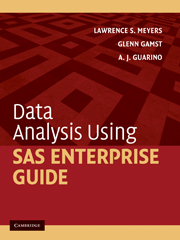Book contents
- Frontmatter
- Contents
- Preface
- Acknowledgments
- I Introducing SAS Enterprise Guide
- II Performing Analyses and Viewing Output
- III Manipulating Data
- IV Describing Data
- V Score Distribution Assumptions
- VI Correlation and Prediction
- VII Comparing Means: The t Test
- VIII Comparing Means: ANOVA
- IX Nonparametric Procedures
- 27 One-Way Chi-Square
- 28 Two-Way Chi-Square
- 29 Nonparametric Between-Subjects One-Way ANOVA
- X Advanced ANOVA Techniques
- XI Analysis of Structure
- References
- Author Index
- Subject Index
28 - Two-Way Chi-Square
Published online by Cambridge University Press: 05 June 2012
- Frontmatter
- Contents
- Preface
- Acknowledgments
- I Introducing SAS Enterprise Guide
- II Performing Analyses and Viewing Output
- III Manipulating Data
- IV Describing Data
- V Score Distribution Assumptions
- VI Correlation and Prediction
- VII Comparing Means: The t Test
- VIII Comparing Means: ANOVA
- IX Nonparametric Procedures
- 27 One-Way Chi-Square
- 28 Two-Way Chi-Square
- 29 Nonparametric Between-Subjects One-Way ANOVA
- X Advanced ANOVA Techniques
- XI Analysis of Structure
- References
- Author Index
- Subject Index
Summary
Overview
A chi-square test can be applied to two-way designs as well as to the one-way designs we covered in Chapter 27. The simplest two-way design is a 2 × 2 and we illustrate it in Figure 28.1. Assume we asked business travelers which of two attributes they valued most in a hotel when they were traveling on business. The row and column variables each have two levels, and the uppercase letters in the cells represent the observed frequencies. Each row and column has a total frequency (e.g., A + B is the total number of women in the study), and the total sample size (N) is the sum of all cell frequencies.
Frequency tables such as we have drawn in Figure 28.1 are called contingency tables. This is because the observed frequency is contingent on two (or more) conditions. For example, the frequency of selecting location over service may depend (be contingent) on whether the business traveler is a woman or a man. In two-way contingency tables, such as shown in Figure 28.1, the null hypothesis on which the expected frequencies is based can be stated in several different ways:
Preference for hotel location and service is independent of (unrelated to) the gender of the traveler.
The variables of hotel attribute and gender are independent (not related).
Women and men business travelers have comparable preferences for hotel location and service.
The proportion of women preferring location to service is not statistically different from the proportion of men preferring location to service.
- Type
- Chapter
- Information
- Data Analysis Using SAS Enterprise Guide , pp. 279 - 290Publisher: Cambridge University PressPrint publication year: 2009



